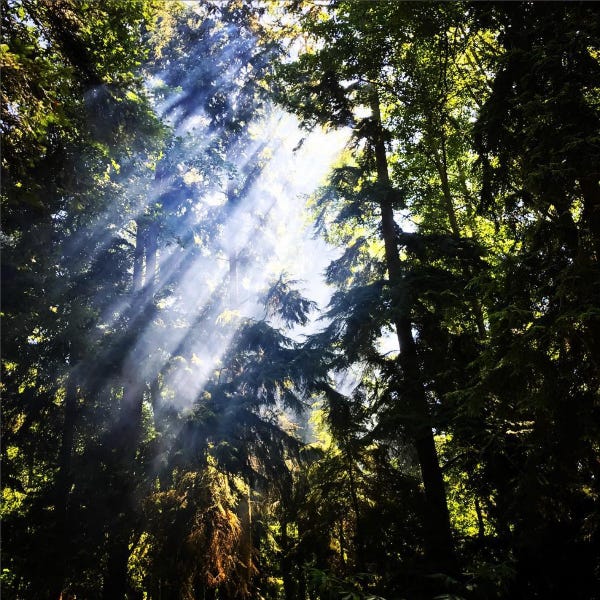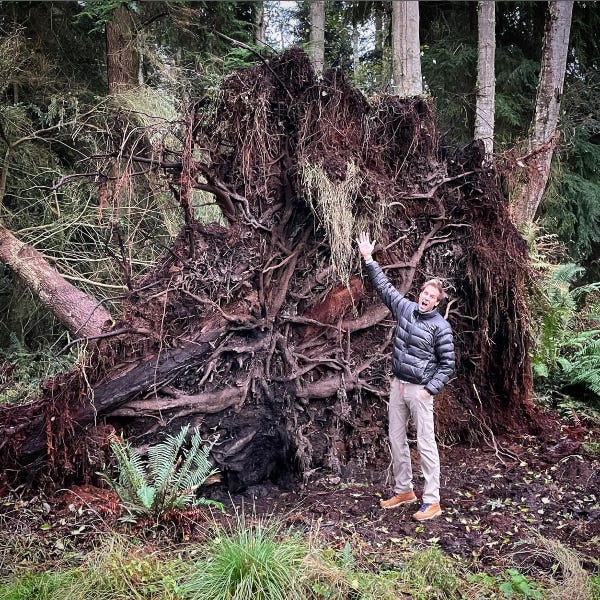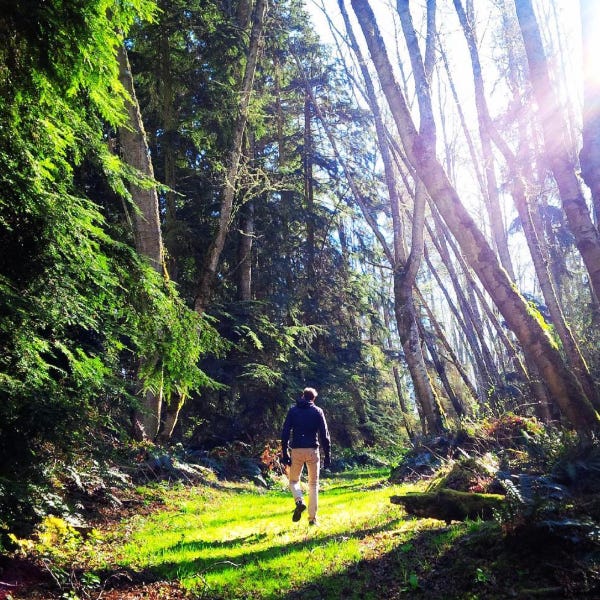The Forest Through the Trees
Reflections on human life in the shadow of trees.
“The creation of a thousand forests is in one acorn.” ― Ralph Waldo Emerson
A few miles up the road from our home is the last remaining stand of old-growth forest on the island here. There you can walk among giant Douglas fir with deeply furrowed bark blackened by centuries of fire or sink your toes into a carpet of moss covering the intertwined roots of towering Sitka spruce and listen to subterranean streams trickling beneath your feet. It’s a wonderland. But by far the star of this stroll through antiquity is an old-growth western redcedar that is more than 500 years old.
A visit to this ancient conifer is a cure for depression and mania alike. I sometimes sit on the bench at its base and marvel at the human history this tree has presided over. It was a seed drifting on the same breeze that circled the globe to fill the sails of that most famous Genoese sailor as he set off from Spain. It was a sapling when Leonardo picked up his brush. It was a healthy young tree when the Aztecs expelled the Spanish, and it was already producing its own seed when the Pope was burning Martin Luther’s writings in Rome. It was fully mature when one-week-old Mary Queen of Scots inherited her throne, and it had stood nearly a century by the time Shakespeare was born. It was already an old-growth veteran, having stood against three hundred winters, by the time The Continental Congress gathered to declare the King a tyrant. It has borne witness to the birth and death of entire nations.
(An interactive 360-degree view of this cedar can be found here.)
When the forested acreage adjacent to our home was set to be sold, we snatched it up before it could be put on the market. We had selfish reasons, of course. Privacy for one. Protecting the value of our home for another. But also, at work in us was the fear that someone would clear the beautiful aging alders and second-growth conifers to gain a view of the water and build one of the enormous homes that have become popular in this area, and in most of the rest of America. It was the best decision we could have made.
In the summer we step from the noisy sunlight into a quiet shade-dappled world that seems to breathe at a slower pace, exploring deer trails and observing wildlife hidden in the understory of salmonberry and sword fern. Its canopy shields the wanderer from rain, and at other times captures the marine fog and makes its own. It filters the light into something tangible and magic. A forest is a special place indeed, but a forest can also be foreboding.
The wood that beckons in summer, tries to kill you in winter. Only a fool would enter a forest during a windstorm. I’ve been that fool. The sound is deafening. A cacophony of the whoosh of wind whipping through the treetops and the creak of swaying trunks strained to their limit, as huge tree-sized limbs splinter free and rain down like javelins and impale themselves with a tha-rumph! so deeply into the rocky clay beneath the duff that they cannot be pulled out again and must be felled later like standing trees with a chainsaw. A helmet perhaps? Ha-ha! Even a car roof would slow these falling branches only the fraction of a second one would need to know that they were dead. Sometimes whole trees come down, or worse, the top half of a tree, and the ground shakes when they hit.
I’ve learned to let these storms pass and survey the destruction after. But even then, there are perils. I’ve spent hours working out complicated trigonometry and physics problems beyond my reckoning, attempting to calculate the angles of potential energy of a fallen tree caught up in the crooks of others yet standing, only to surrender to my gut instinct and make the final cut with my chainsaw and watch with relief as the freed snag swings away from me with enough force to kill an elephant. What if I’d guessed wrong? Guess wrong and you never guess again. Forestry is a dangerous endeavor, and probably one a layman like me has little business doing.
“Trees are poems that the earth writes upon the sky.” ― Kahlil Gebran
During one of these storms a large hemlock was toppled, its roots ripped right out of the earth, still clutching builders and half-rotten logs now suspended ten feet in the air. In the soil beneath the upturned roots I found an old sardine tin, doubtless the remains of some logger’s lunch. I sat looking at this tin for a long time. Who was the man who had eaten them, I wondered? Had he sat where I was sitting and joked with his fellows while they passed a flask of moonshine after lunch? Did they follow the trees as horses pulled them to the cove, or did they drop them and leave them where they lay for others to move?
When I finally bucked up the fallen hemlock, I counted the growth rings. More than a hundred years had passed since that hemlock took seed on the site of that long-ago lunch. I marked off the passing years, ring by ring, and pondered in which of them my logger might have died. I found myself hoping he’d survived long enough to hang up his saw and grow to be an old man, showing pictures of himself straddling downed timber on skids to his grandkids.
There are old-growth stumps deep in our forest on which you can still see the springboard notches where these loggers stood across from each other on planks above the butt-swells, cutting them down by hand with vintage crosscut saws. Did they yell “Timber!” or is that just in films? Most of these old stumps have mature nurse trees growing out of them now, as if they patiently regenerated to spite the men who had felled them, only to find their mortal foes long since vanished, not merely from the forest, but from the face of the earth.
I often wonder where these old trees from our property went. How many of them sailed away to rebuild San Francisco after the great fires? How many became ship masts? Of those, what foreign ports did they visit? On what seafloor do they now lay? Such are the things one thinks about in a forest while contemplating stumps.
In these stumps, I find the roots of our complex existence and the limits of our understanding, too. This island has lovely forests, but it is especially bucolic because of its fields. Where the woodlands lead one’s thoughts inward, an open field invites the eye and mind to wander; where an impenetrable tangle of pitfalls and snags once stood, now stretch golden fields that feed us. Early settlers cleared acres of trees, with nothing but old saws and hatchets and maybe a few oxen to pull the stumps, toiling to turn the rich soil created by thousands of years of tree litter into productive farmland.
Some of the island’s farmland is so beautiful it is now protected as a National Historic Reserve. But how historic? Just two centuries ago it was all forest. And ten millennia ago, when the glaciers first receded, and before the land sprang back, it was all under sea. And before that it was hidden beneath a mile of ice. I know all this, but I don’t really understand it. I can’t. The scale is too big. It’s like trying to describe standing on the moon in the space of a postcard or capturing Mount Everest in a single snapshot. It can’t be done. But I can sit on that bench and look up at that old cedar. It’s still here after five centuries, and it’s still alive. It probably will be after I’m gone. That I can understand.
In 1977, when I was just two-years old, and when our home here was being constructed almost exclusively from old-growth fir and cedar, a husband and wife chained themselves to this storied cedar to prevent it from being felled. The result was 255 acres being added to the state park system and protected forever.
There are contradictions here that confound, and I don’t pretend to know where the proper balance lies. I do, however, sense hypocrisy when I see current neighbors putting signs on the closed gates of their newly constructed multi-million-dollar mansions calling for the removal of hydroelectric dams or condemning local logging proposals. “We’re good people,” these signs seem meant to convey, and by contrast, one can only assume that those lousy loggers and engineers who made it all possible were not. If only it were so simple though. I doubt their imported custom cabinetry holds tins of sardines. I doubt they’d chain themselves to a tree. I know their hands will never feel the pain of pulling a stump out of glacial till in the dead of winter.
In our case, self-interest aligned with our ethics just enough to save one small portion of second-growth forest from the axe. That, and we were in the fortunate position to be able to afford to do it. Not everyone is so lucky. And if I’d needed a site to build a house for my family, or even money to feed them, those trees would be at the lumber mill as fast as I could fell them. I’ve yet to figure out how to fit this sentiment on a sign for my gate.
I sometimes suspect we’d accomplish more toward future conservation than we ever could in the classroom by sending our children out to climb trees, to return to the branches where we once sought shade and shelter, to dig through the forest duff in search of hidden critters and rusted treasures. Perhaps we do. I don’t really know. But everything seems so academic now. Everything’s a scary headline above a colored graph on a computer screen, or a slogan on a meme. But there’s a difference between “knowing” the value of something intellectually and being consciously aware of its real value to ourselves, as humans who eat and breathe and live and die; between thinking we’re so very important and knowing that our lives fit between just so many growth rings exposed on the stump of a felled tree.
“Between every two pines is a doorway to a new world.” ― John Muir
I don’t know how I’d have felt about those folks who chained themselves to that cedar if I’d been an adult and their neighbor then. Experience tells me that people so passionate about a single issue are often difficult to be around, especially when they’re your contemporaries. But I know how I feel about them now. I feel admiration and gratitude. And yet I feel the same for those young men who left behind stumps here, and for those who carved farmland from the forest, and for those who later built this old house.
What a beautiful labyrinth of contradictions one sometimes finds in a forest, and what a complicated, twisted path reveals itself everywhere humans tread. As for me, I’m well aware it’s a luxury to be able to let our trees stand, to preserve them, just as it’s a blessing to hike up the road and sit in the shade of that ancient cedar that others sacrificed so much of their precious time and energy to protect.
A few summers ago, I lost a pair of pruning shears in our forest. I gave up looking for them. They’ve settled into the duff and been covered over by now. It makes me smile to think that perhaps some future windstorm will turn over a tree that is now just a seed on the breeze, and that someone not yet born might sit in this forest looking at those rusted shears revealed in the clay and contemplate the life and death of their owner. In which ring will it be? I don’t know. I don’t want to. But I hope it happens. I hope the trees are still here. I hope we’re still here.
Until then, I’m here now. And so are you. But it’s all so very fleeting, isn’t it? Trees make that clear. But there’s beauty in this life, perhaps because it’s ephemeral. I suspect it takes a great deal of patience to stand as long as that cedar has, and blood runs faster than sap. Patience is not what we’re good at. Today, I’ll settle for enough patience to enjoy an hour or two on a bench in the shade of something much bigger and far older than myself.
As I finished typing this just now, the Moody Blues song “Watching and Waiting” came up on my morning playlist, and I heard these fitting lines:
'Cause here there's lot of room for doing The thing you've always been denied Look and gather all you want to There's no one here to stop you trying Soon you will see me 'Cause I'll be all around you But where I come from I can't tell But don't be alarmed by my fields and my forests They're here for only you to share
An audio recording of this essay can be found here:






As a native of Seattle and a Native American, I share in your contemplation of trees, life, death and progress. Asking of ourselves, of our society and of our leaders is, at times a frustrating proposition.
I myself tend to ponder the past and future, focused on my present and the gifts which I could share to make a small, yet positive difference in the world.
Your gift is in text and in living a good life.
For that, I thank you.
Really enjoyed reading this. Thank you